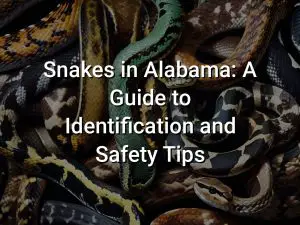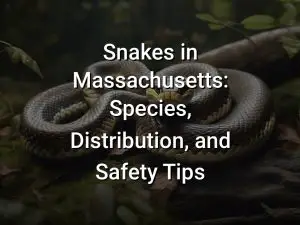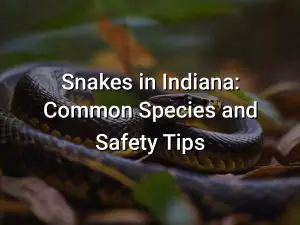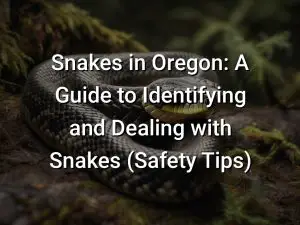Snakes in Rhode Island: Common Species and Safety Tips
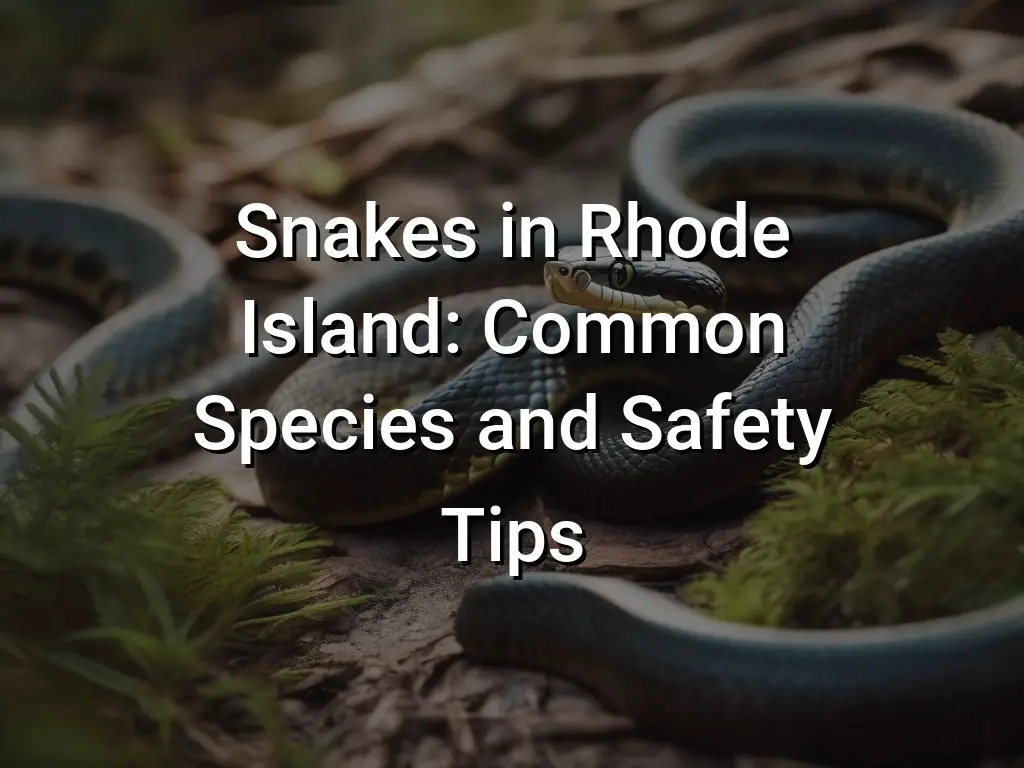
Snakes in Rhode Island may not be the first thing that comes to mind when thinking about the ocean state, but they are a fascinating part of its ecosystem. From the venomous Diamondback Rattlesnake to the harmless Garter Snake, Rhode Island is home to a variety of snake species. In this article, we’ll explore the common snake species found in Rhode Island and provide some safety tips for encountering these slithery creatures.
Whether you’re an avid herpetologist or simply curious about the wildlife in your area, learning about snakes can be both educational and exciting. From their distinct patterns and behaviors to their important role in the ecosystem, snakes are truly remarkable creatures. So, keep reading to discover more about the snakes of Rhode Island and how to coexist with them safely.
Quick Links
Diamondback Rattlesnake
The Diamondback Rattlesnake is a venomous snake species that can be found in Rhode Island. It is named for the diamond-shaped patterns on its back and the rattle at the end of its tail. The Diamondback Rattlesnake is known for its distinctive warning rattle, which it uses to deter potential threats.
This species is typically found in wooded areas, rocky terrains, and fields. It is important to exercise caution when in these environments to avoid accidental encounters with the Diamondback Rattlesnake.
If you do come across a Diamondback Rattlesnake, it is essential to keep a safe distance and avoid any sudden movements. These snakes are generally shy and will only bite if they feel threatened or provoked. It’s best to admire them from a distance and not disturb their natural habitat.
When hiking or exploring areas where Diamondback Rattlesnakes may be present, it is recommended to wear long pants, closed-toe shoes, and stay on marked trails. This reduces the risk of accidentally stepping on or startling a snake.
If you are bitten by a Diamondback Rattlesnake, seek immediate medical attention. Do not attempt to capture or handle the snake yourself. Call emergency services and follow their instructions while waiting for help to arrive.
It is important to remember that snakes, including the Diamondback Rattlesnake, play an important role in the ecosystem by controlling populations of rodents and other small animals. They are part of the natural biodiversity of Rhode Island and should be respected and appreciated from a safe distance.
Eastern Rat Snake
The Eastern Rat Snake, also known as the Black Rat Snake, is a common species of snake found in Rhode Island. It is non-venomous and can grow up to 8 feet in length, making it the largest snake species in Rhode Island.
The Eastern Rat Snake is known for its glossy black color and white or yellowish chin and throat. It has a slender body and a pointed head. This snake is a skilled climber and can often be found in trees or on fences.
- They primarily feed on small mammals, birds, and their eggs.
- They are active during the day and are often seen basking in the sun.
- Eastern Rat Snakes are important for controlling rodent populations.
- If threatened, they may inflate their bodies and emit a foul-smelling musk as a defense mechanism.
- They are generally non-aggressive towards humans and will try to escape if encountered.
It’s important to remember that although the Eastern Rat Snake is non-venomous, it is still capable of biting, and any snake should be treated with caution and respect. If you encounter a snake, it’s best to keep your distance and allow it to move away on its own.
Northern Water Snake
The Northern Water Snake (Nerodia sipedon) is a common snake species found in Rhode Island. As the name suggests, they are often found near bodies of water such as rivers, lakes, and ponds. These snakes are non-venomous and are known for their ability to swim and dive underwater.
The Northern Water Snake is typically dark brown or gray with dark, blotchy markings along its body. They have a thick body and a rounded flat head. These snakes can grow up to 4-5 feet in length.
Northern Water Snakes are active during the day and are often seen sunning themselves on rocks or logs near the water. They are opportunistic feeders and primarily eat fish, frogs, and small mammals. Despite their name, they are not limited to water and can be found in a variety of habitats, including grasslands and forests.
While Northern Water Snakes are not venomous, they can be aggressive if they feel threatened. They will bite and release a musky odor as a defense mechanism. It is important to give these snakes their space and avoid handling them.
If you encounter a Northern Water Snake in the wild, appreciate it from a distance and allow it to go about its natural behaviors. Remember that these snakes play an important role in the ecosystem as predators of small animals and help control their populations.
Black Rat Snake
The Black Rat Snake, also known as the Eastern Rat Snake, is a common snake species found in Rhode Island. It is a non-venomous snake and is beneficial for controlling rodent populations.
Black Rat Snakes have a sleek black body with a white or gray belly. They can grow up to 6 feet in length and are known for their climbing abilities. These snakes are often found in wooded areas, farmland, and even in suburban areas, where they hunt for small mammals, birds, and eggs.
If you come across a Black Rat Snake in Rhode Island, it is important to remember that they are not venomous and are generally non-aggressive towards humans. However, if threatened, they may hiss, strike, or release a foul-smelling musk as a defensive mechanism. It is best to observe them from a safe distance and not to provoke or handle them.
If you encounter a Black Rat Snake in your home or property and would like to remove it, it is recommended to contact a professional wildlife removal service. They have the necessary knowledge and equipment to safely and humanely relocate the snake.
Remember, snakes play an important role in the ecosystem and should be respected and appreciated for their contributions.
Northern Copperhead
The Northern Copperhead (Agkistrodon contortrix mokasen) is a venomous snake that can be found in Rhode Island. It is a medium-sized snake, averaging between 2 and 3 feet in length, with a stout body and distinct copper-colored head. The body is covered in dark brown or reddish-brown crossbands that are wider on the sides and narrower towards the spine.
The Northern Copperhead is primarily active during the warmer months and can be found in a variety of habitats, including forests, fields, and rocky areas. It is a solitary snake that hunts for small mammals, birds, and amphibians, using its venomous bite to immobilize its prey.
Encountering a Northern Copperhead in Rhode Island is rare, but if you do come across one, it is important to exercise caution. The snake’s venom can cause pain, swelling, and tissue damage, but it is rarely life-threatening for humans. If you are bitten by a Northern Copperhead, seek medical attention immediately.
To stay safe and reduce the risk of snake encounters, it is recommended to:
- Stay on designated trails and avoid walking through tall grass or brushy areas where snakes may hide.
- Wear sturdy shoes and long pants when hiking or exploring snake habitats.
- Be aware of your surroundings and watch where you step or place your hands.
- Keep your distance if you see a snake and do not attempt to handle or provoke it.
- Teach children about snake safety and the importance of not touching or approaching snakes in the wild.
Remember, snakes play an important role in the ecosystem and should be respected from a safe distance. By following these safety tips, you can enjoy Rhode Island’s natural landscapes while minimizing the risk of snake encounters.
Smooth Green Snake
The Smooth Green Snake (Opheodrys vernalis) is a nonvenomous snake species commonly found in Rhode Island. As the name suggests, this snake has a vibrant green coloration that helps it blend into its natural surroundings, such as grassy areas and forests.
Smooth Green Snakes are relatively small, usually measuring around 14 to 20 inches in length. They have slender bodies and smooth scales, which give them a sleek appearance. Their eyes are large and their heads are small, making them look quite delicate.
These snakes are primarily insectivores, feeding on a diet of small insects and spiders. They are excellent climbers and can sometimes be found in low tree branches, hunting for prey or sunning themselves.
While Smooth Green Snakes are generally harmless to humans, they are known to be quite shy and will typically flee if encountered. If you do come across a Smooth Green Snake, it’s best to observe it from a distance and not try to handle or disturb it.
In Rhode Island, the Smooth Green Snake is considered a species of special concern due to habitat loss and fragmentation. It is important to protect their natural habitats and refrain from capturing or harming these snakes.
If you happen to see a Smooth Green Snake in your yard or in a natural area, consider yourself lucky to catch a glimpse of this beautiful creature in its natural habitat. Just remember to appreciate it from a distance and let it go about its business undisturbed.
Garter Snake
The garter snake is one of the most common snake species that you may come across in Rhode Island. It is known for its slender body and distinct stripes running along its length. Garter snakes are non-venomous and are generally harmless to humans, making them a common sight in gardens, fields, and even residential areas.
These snakes are generally docile and will only bite if they feel threatened. If you encounter a garter snake, the best course of action is to leave it alone and give it space to retreat. Garter snakes primarily feed on small prey such as insects, slugs, and worms, which makes them beneficial for pest control in gardens.
If you have a garter snake in your garden and want to encourage it to move elsewhere, simply remove any potential hiding spots such as piles of debris or wood. Alternatively, you can create a designated snake habitat in a more secluded area of your property to attract the snakes away from high-traffic areas.
It is important to note that while garter snakes are harmless, it is still recommended to exercise caution and avoid handling them. If you do get bitten by a garter snake or any other snake, seek medical attention immediately, as a small percentage of people may have allergic reactions to snake venom.
Overall, garter snakes are beneficial and fascinating creatures that play an important role in balancing ecosystems. When encountered in their natural habitats, they should be appreciated from a respectful distance.
Brown Snake
The brown snake, also known as the DeKay’s snake, is a small and non-venomous snake that is commonly found in Rhode Island. It is a harmless species that can be identified by its brown or gray coloration and its small size, averaging about 9 to 15 inches in length.
Brown snakes are typically found in a variety of habitats, including forests, grasslands, wetlands, and suburban areas. They are secretive and nocturnal, often hiding under rocks, logs, or leaf litter. They feed on small invertebrates, such as slugs, snails, worms, and insects.
While brown snakes pose no threat to humans, they may release a foul-smelling musk when handled or threatened. This is their defense mechanism to deter predators.
If you encounter a brown snake, it is best to observe it from a distance and let it go about its business. They play an important role in keeping the ecosystem in balance by controlling populations of pests like slugs and insects.
Remember, when encountering any snake in the wild, it’s important to respect their space and not attempt to handle or disturb them.
Ring-necked Snake
The ring-necked snake is a common snake species found in Rhode Island. It is a small, non-venomous snake that can reach lengths of up to 15 inches. The name “ring-necked snake” comes from the distinctive yellow or orange ring around its neck.
Ring-necked snakes are usually found in wooded areas, grasslands, and marshes, where they hide under logs, rocks, and leaf litter. They are mostly active at night and feed on small prey such as insects, worms, and slugs.
Despite their small size, ring-necked snakes can exhibit defensive behavior when threatened. They may coil up and raise their tail tip, which is brightly colored, in an attempt to deter predators. However, they are harmless to humans and rarely bite.
If you encounter a ring-necked snake in Rhode Island, it is best to admire it from a distance and avoid handling it. These snakes play an important role in the ecosystem by controlling populations of small pests like insects and slugs.
Remember, snakes are generally beneficial for the environment and should be respected and left undisturbed. If you have concerns about snakes in your area, it is best to contact local wildlife authorities for guidance and assistance.
Eastern Milk Snake
The Eastern Milk Snake is a common snake species found in Rhode Island. It is a non-venomous snake that belongs to the Colubridae family. This species is known for its distinct coloration, which resembles that of the venomous Eastern Coral Snake.
Eastern Milk Snakes have a brown or grayish body with dark red or reddish-brown blotches bordered by black bands. The belly is usually a light cream or yellow color with black markings. The head is slightly triangular in shape and often has a dark-colored dorsal stripe.
These snakes are typically found in a variety of habitats, including forests, fields, and rocky areas. They are primarily active during the day and are often seen sunning themselves on rocks or logs. Eastern Milk Snakes feed on a diet consisting mainly of small rodents, birds, and their eggs.
When threatened, Eastern Milk Snakes will often vibrate their tails and emit a musky odor to deter predators. They are generally docile and non-aggressive towards humans but may bite if provoked or handled improperly. However, their bite poses no serious threat to humans and is usually harmless.
If you encounter an Eastern Milk Snake in Rhode Island, it is best to observe it from a safe distance and avoid disturbing or attempting to capture it. Snakes play an important role in the ecosystem by helping to control rodent populations, so it is best to leave them undisturbed in their natural habitat.
Conclusion
While Rhode Island is home to a variety of snake species, most of them are harmless and play an important role in maintaining the ecosystem. It’s important to be aware of the common snake species in the area and to understand basic safety tips when encountering them in the wild.
Remember, snakes usually prefer to avoid humans and will only bite if they feel threatened. By keeping a safe distance, wearing appropriate footwear and clothing, and staying alert in snake-prone areas, you can reduce the risk of snake bites and enjoy your outdoor adventures with peace of mind.
Stay safe and happy exploring!


